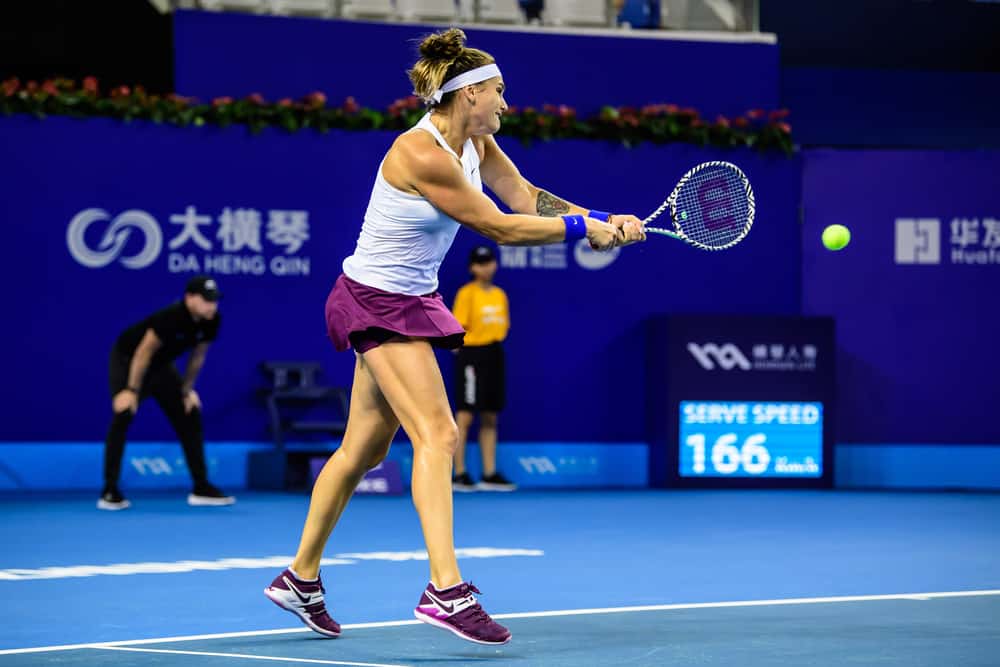Tennis is a sport that demands a combination of physical fitness, technical skill, and mental toughness from its players. One of the most impressive aspects of a tennis player’s game is their serve speed. The speed at which a player can serve the ball can be a measure of their strength, skill, and overall ability on the court.
POINTS
- Tennis is a sport that requires physical fitness, technical skill, and mental toughness from its players. Serve speed is an impressive measure of a player’s strength, skill, and overall ability on the court.
- Several factors affect serve speed, including physical strength and fitness, technique, and form, type of serve as well as court surface conditions.
- Professional players are known to have incredibly high serve speeds, with some exceeding 140 mph for men or 120 mph for women. The average professional player has significantly higher serves than amateurs, who range between 70-80 mph in the male category or 60-70mph in the female category.
- To improve one’s own service speed, there needs to be a focus on building up physical strength through conditioning exercises such as weightlifting combined with working on improving technique & form, which includes grip stance & follow-through drills like practicing serves from backcourt or using weights when serving, etc.
Factors that affect serve speed
There are several factors that affect serve speed. This section will cover the player’s physical strength and fitness, technique and form, and type of serve. Court surface and conditions also play a major role in how fast a tennis player can serve the ball to the other side of the court.
Physical strength and fitness
The first factor that affects a player’s serve speed is their physical strength and fitness. A player who is in good physical shape will have more power in their serve and be able to generate more speed on their shots.
Someone who has worked on their upper body and arm strength, in particular, will be able to generate more power and speed on their serve. Regular training and conditioning can help a player improve their physical fitness and serve speed over time.
Technique and form
The next factor that affects a player’s serve speed is their technique and form. A player with good technique and form can generate more speed and power on their serve, while a player with poor technique may struggle to hit the ball with the desired speed and accuracy.
A player can work on their technique and form through regular coaching and practice. It’s important for a player to have a consistent, repetitive serve motion in order to maximize their serve speed.
Type of serve
A player’s type of serve can also affect their serve speed. For example, a flat serve is typically hit with more pace and speed than a slice serve, which is designed to move the ball with spin rather than speed.
A player may choose to use a specific type of serve based on their opponent’s strengths and weaknesses or their own personal preferences.
Court surface and conditions
The final factor that affects a player’s serve speed is the court surface and conditions. Different surfaces and conditions can affect the bounce and movement of the ball and can impact the player’s ability to generate speed and power on their serve.
For example, a player may struggle to generate as much speed on their serve on a slow clay court as they would on a faster hard court. The conditions of the court, such as wind and temperature, can also affect a player’s serve speed and performance.
Record serve speeds in professional tennis
The serve is a crucial aspect of tennis, and professional players are known to have incredibly high serve speeds. Some of the top male players with the highest recorded serve speeds include Ivo Karlovic, John Isner, and Sam Groth.
These players often exceed 140 mph with their serves, making them some of the strongest servers in the sport. On the women’s side, Venus Williams and Kristyna Pliskova have both recorded serve speeds of over 120 mph, making them the fastest female servers in the game.
It’s important to note that the average serve speed for professional players is significantly higher than that of amateur players. This is due to the combination of physical strength, technique, and form that professional players have honed over years of practice and competition. While amateur players may have average serve speeds in the 70-80 mph range, professional players often exceed 100 mph.
How to improve serve speed
If you’re looking to improve your serve speed, there are a few essential tips you can follow. First and foremost, it’s important to focus on building physical strength and conditioning. This will help you generate more power and speed with each serve. Incorporating weight lifting and other strength training exercises into your routine can help you achieve this goal.
In addition to strength training, improving your technique and form is crucial for increasing your serve speed. This means working on your grip, stance, and follow-through. Practicing different types of serves, such as a flat serve or a slice serve, can also help you improve your form and develop more control over your shots.
Finally, there are various drills you can do to specifically target your serve. For example, practicing serves from the back of the court or practicing serves with weights can help you build more power and speed. The key is to consistently practice and focus on improving your technique and form to see actual results in your serve speed over time.
FAQ
How fast is the average serve in tennis?
The average serve speed in tennis is around 80–90 mph for male players and 60–70 mph for female players. It is important to note that the average can vary depending on skill level and other factors such as court conditions and surface.
What is the average male tennis serve speed?
The average male tennis serve speed is around 80–90 mph. However, this can vary depending on factors such as fitness level, technique, and form. The fastest male tennis serves have been recorded at over 140 mph.
What is the average female tennis serve speed?
The average female tennis serve speed is around 60-70 mph, with some of the top female players serving at speeds exceeding 100 mph. Like with male players, factors such as fitness, technique, and form can impact serve speed.
How fast is Djokovic’s tennis serve?
Novak Djokovic’s tennis serve has been recorded at speeds over 130 mph, making him one of the fastest servers in the professional tennis circuit. Djokovic’s impressive serve speed is a testament to his strength, fitness, and technique.
What is Serena Williams’ average serve speed?
Serena Williams is known for her powerful serve, with average speeds recorded at over 100 mph. Her exceptional serve speed results from her physical strength and her mastery of technique and form.
Conclusion
Serve speed is a crucial aspect of tennis and can greatly impact a player’s success. It showcases a player’s physical strength, technique, and form and can make a big difference in game strategy and competitiveness.
Several factors can impact a player’s serve speed in tennis. From physical strength and fitness to technique and form, each factor plays a vital role in determining a player’s overall serve speed. By understanding and working on these factors, players can strive to improve their serve speed and performance on the court.
Whether you’re experienced or just starting out, there’s always room for improvement in how quickly you can serve the ball to the other side of the court. With a combination of physical training, practicing the right techniques, and honing your form, you can increase your speed and become a better tennis player.
So don’t be afraid to work on this aspect of your game, keep pushing yourself to be the best you can be, and continue reading our blog for more helpful tips to help you grow as a tennis player!
 Written by Mark Sampson
Written by Mark Sampson